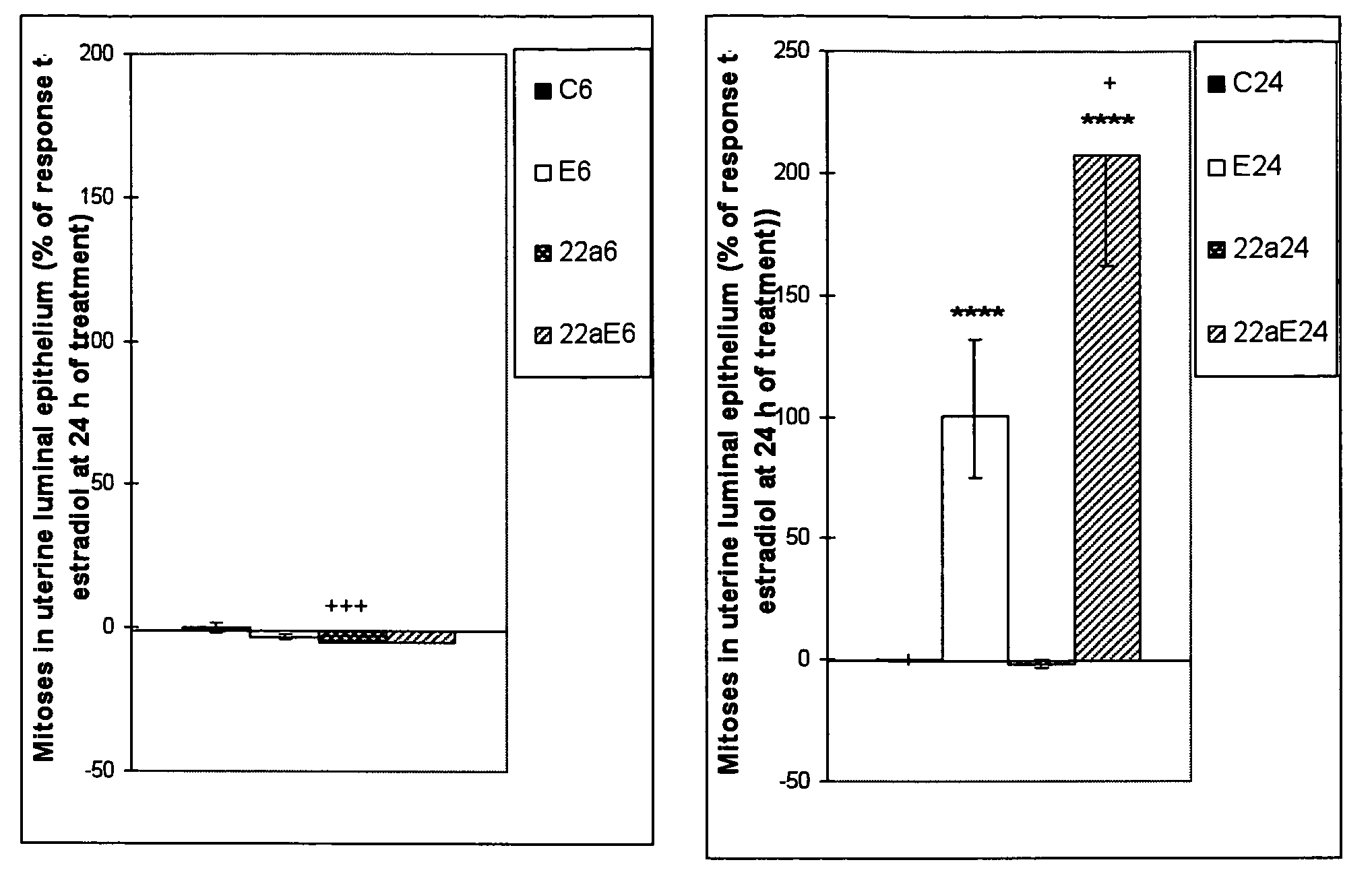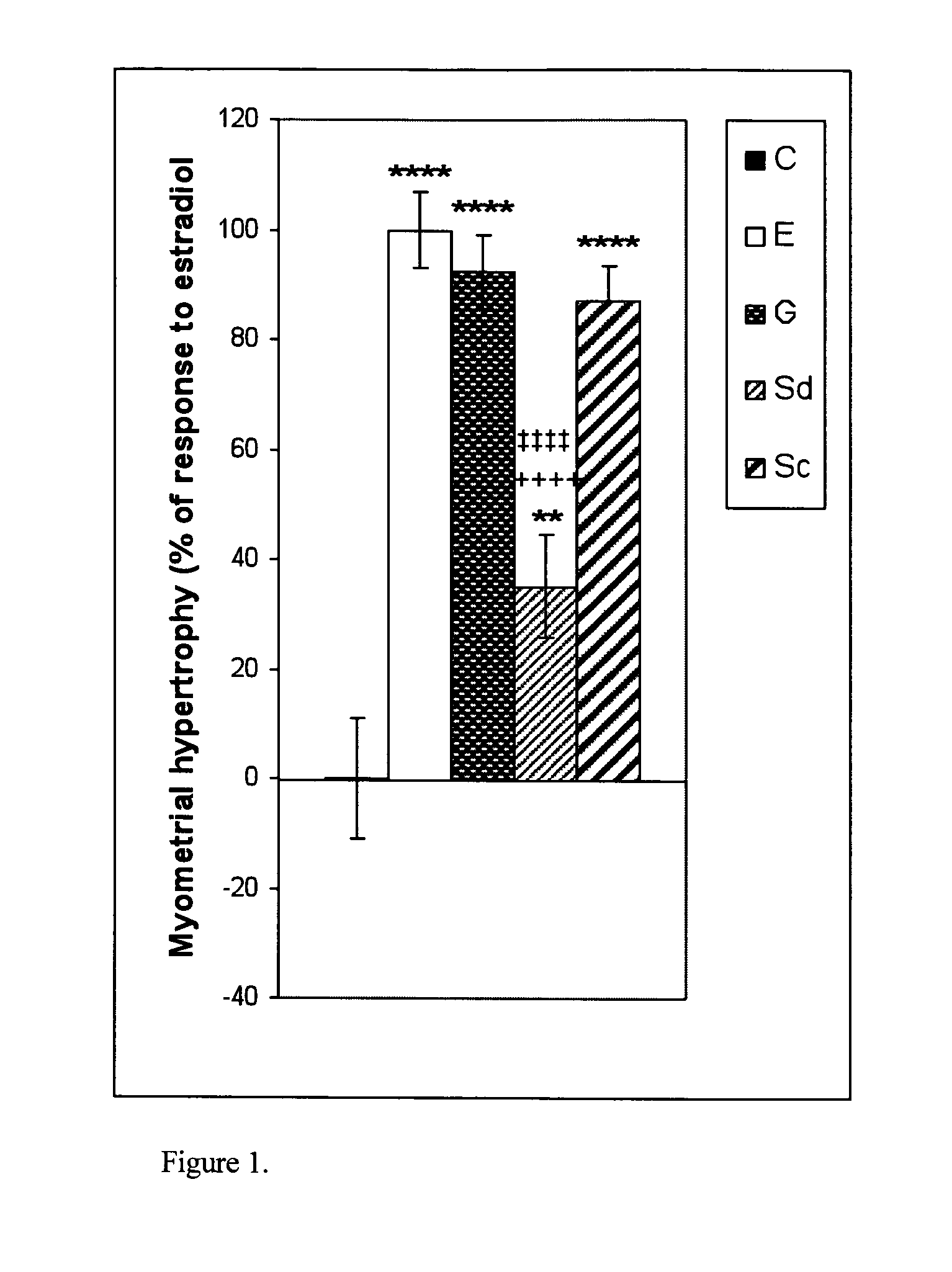Pharmaceutical product and analysis model for hormone replacement therapy for women and prevention of some cancers and uterine myomas
a hormone replacement therapy and analysis model technology, applied in the field of phytochemistry, can solve the problems of increasing the risk of breast or endometrial cancer, no scientific demonstration of the effectiveness of the therapeutic effect, and no knowledge of the molecular mechanisms involved
- Summary
- Abstract
- Description
- Claims
- Application Information
AI Technical Summary
Benefits of technology
Problems solved by technology
Method used
Image
Examples
example 1
Materials and Methods for Testing the Extracts on Animals
[0096]Prepubertal female rats were treated s.c. with the vehicle (C) (0.3 mL 1:9 ethanol saline), or a phytoestrogenic preparation, followed after one hour by estradiol-17β (E) Merck (0.33 mg / kg b.wt.), or its vehicle. Among the phytoestrogenic compounds used, genistein (G) Sigma (0.5 mg / kg b.wt.), two different concentrations of soybean ethanol extracts (S): 0.06 (Sd) and 0.364 (Sc) mg genistin / kg b.wt., and extracts, decoctions or extract sub-fractions of various plant species. Genistein quantification was based in the indirect valoration of genistein following 2M HCl hydrolysis and genistein quantification by HPLC (45, 46). Other ethanol extracts, decoctions and extract fractions from several plant species, as suggested by ethno-medicinal knowledge, were additionally assayed, from which only those displaying promising results for therapeutic applications are shown (vide infra). Uteri were excised under ether anesthesia and ...
example 2
Plant Extracts
[0103]Plant extracts used were obtained by extracting specified plant material with absolute ethanol Merck for 72 hours at room temperature (20-25° C.) in dark bottles protected from the sunlight. In addition, other methods of plant extractions were performed, including extractions with solvents of different polarity, and various extract fractions were obtained. The decoctions were made in distilled water, boiling plant material for 20 minutes; following cooling of the extract it was mixed 1:1 in absolute ethanol.
Calceolaria filicaulis Clos ssp luxurians (Witasek) C. Ehrhart—Extract (Le81a)
[0104]Genus Calceolaria (Scrophulariaceae) in Chile is represented by approximately fifty species [2], some of which are used as stomachic drugs, sweetening agents and against bacterial infections.
[0105]Calceolaria filicaulis is a native Chilean plant belonging to the family Schrophulariaceae. The genus Calceolaria has about fifty species and some of them have been traditionally used...
example 3
Genistein and Soy Bean Extracts
Agonist Action
[0113]Myometrial hypertrophy was induced by E, G and two concentrations of S; G and Sc produced a response similar to E, while Sd induced a weaker response than that obtained with E (FIG. 1). Endometrial luminal epithelial cell hypertrophy (FIG. 2) and RNA content (FIG. 3) was induced by E, G Sd and Sc, although a response similar to E was achieved by G only; the responses to Sd and Sc were significantly weaker than that to E. Edema in deep endometrial stroma was induced by E only (FIG. 4). A normal intensity estrogen-induced uterine eosinophilia was observed following E treatment only, although a very slight but statistically significant response was also observed with Sd (FIG. 5). As compared to E-treated animals where most uterine eosinophils were located in endometrium with myometrium, in S treated animals there were more eosinophils in the mesometrium than in endometrium with myometrium, and following G treatment all the eosinophils ...
PUM
 Login to View More
Login to View More Abstract
Description
Claims
Application Information
 Login to View More
Login to View More - R&D
- Intellectual Property
- Life Sciences
- Materials
- Tech Scout
- Unparalleled Data Quality
- Higher Quality Content
- 60% Fewer Hallucinations
Browse by: Latest US Patents, China's latest patents, Technical Efficacy Thesaurus, Application Domain, Technology Topic, Popular Technical Reports.
© 2025 PatSnap. All rights reserved.Legal|Privacy policy|Modern Slavery Act Transparency Statement|Sitemap|About US| Contact US: help@patsnap.com



